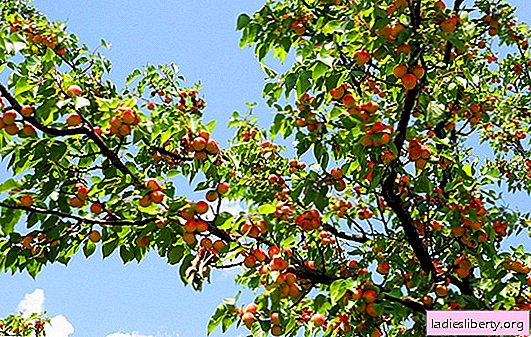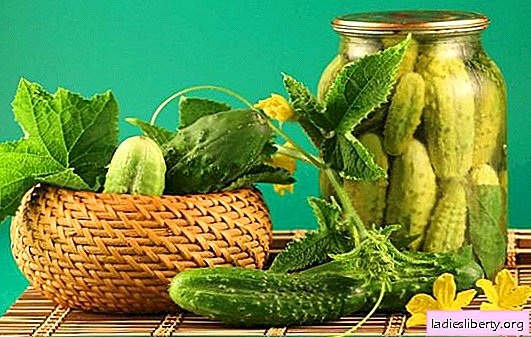
It is very sad to watch the apricot dry.
For a year, or maybe more, the tree pleased with ripe fruits, and then suddenly it began to wither before our eyes.
Apricot death must not be allowed, early diagnosis will help in the treatment.
Apricot tree whimsical to weather conditions can be grown from seed or rootstock.
Spring is the best time to plant. Trees are planted from the south or southeast side, in places protected from the north winds.
Apricots pick when they reach harvesting maturity, because the fruits do not ripen after they are picked from a branch. When harvesting fruits, they move from the periphery to the center, from bottom to top, to avoid accidentally knocking down apricots.
Why does the apricot dry?
There are several reasons for the drying of apricot trees. These are temperature differences, and accidental damage to the trunk, and fungal diseases, and much more.
Most often, young trees are subject to drying. Particular attention should be paid to drying or color-changing sheets. Color change may be the first messenger of problems, in turn, early diagnosis will help preserve the trees.
Apricot dries due to weather conditions.
With sharp changes in temperature, there is a high probability of apricot disease of apricot trees. A fluctuation around zero is especially dangerous, because at freezing temperatures water freezes, which already begins to circulate in the roots of the tree.
Apoplexy is caused by metabolic disorders..
Symptoms are leaves and branches that suddenly wither. The wood dries on the affected part of the tree. Apoplexy is the reason why a tree is vulnerable to other diseases.
For planting, be sure to choose a suitable place: warm with well-drained soil. Shelter of young trees for the winter is a prerequisite for the care of young apricots.
Apoplexy treatment: circumcision of affected branches. Places of cuts are treated with a solution of copper sulfate (1 tsp per 1 liter) and covered with garden var.
In sunny weather, at the end of October, it is necessary to whitewash the trunk and spray the tree with a solution of 2% Bordeaux fluid. Repeat spraying in early spring.
Pests and diseases of the apricot tree: the cause of apricot drying
Moniliosis - fungal disease, carried by wind and insects. Increased likelihood of illness when apricot blossoms in cloudy weather mainly.
Symptoms of this disease: the flowers become brown, over time, the leaves begin to fade, young branches dry out, the bark cracks on thick branches.
For the treatment of monoliasis, the affected branches of the fruit are removed, with the cultivation of the places of slices treated with garden varieties. The tree is sprayed with a 1% solution of Bordeaux fluid.

Verticillosis - a fungal disease that occurs from the decomposition of plant fallen leaves, branches and fruits. Infection occurs through damaged roots or the lower part of the trunk.
Symptoms are yellowing and falling of the lower leaves of the crown. In this case, the trunk and the upper part of the crown remain apparently healthy.
Treatment is relevant only in the very initial stages. The tree is sprayed with a 0.2% solution of foundationazole, topsin-M or similar liquids.
Infectious drying - This is a fungal or bacterial disease that affects trees that grow under inappropriate conditions, both for the soil and the temperature difference, leading to a violation of the integrity of the bark. Most often, apricots are prone to infectious drying at the age of 3 to 12 years.
Symptoms are flowers and leaves that dry but do not fall. At the same time, the leaves themselves are smaller than usual, the apricots that are set are small, almost not stained and bitter. The bark on the trunk is cracking and peeling.
Prevention and treatment - cutting of shrunken branches and leaves. You should cover the young trees for the winter, do not forget about the whitewashing of the trunk. Processing trees with Bordeaux fluid in the fall and spring will reduce the likelihood that the apricot will dry out.
Leaf curl - a fungal disease that occurs in fallen leaves, while it is possible to preserve the spores of the fungus in the cracks of the bark during the winter.
Symptoms - a thickening between the nodes and shortening the distance between them. The leaves of the tree change shape, become light green and thicken, covered with a coating of fungus spores. Affected shoots dry out.
As treatment and prevention, 2% copper sulphate is treated in young kidneys with a repetition after about 3 days.
Pests
The most harmful insects for trees are the Commodity Scutellaria, Glassbasket and Fruit Striped Moth. If you do not take anything in time, the consequences can be sad - the apricot dries.
Comma scale - It looks like a small growth in the form of a comma on a tree trunk. If the entire branch is covered with a scab, then it dies very quickly, and the tree itself gradually loses its strength, since it is exhausted with almost imperceptible “commas”.
Prevention - planting only healthy trees. If the prevalence of the thyroid gland is detected, remove and burn the affected branches.
Glassmaker - a butterfly whose larvae harm normal sap flow due to the fact that during the course of life they make moves under the bark of a tree. Caterpillars are white-yellow in color with a red tint and a brown head.
Treatment - maintaining the good condition of the trees, coating the trunk with a mixture of clay and manure, which blocks the flight of butterflies and hamper the movement of larvae.
Fruit striped moth - a night butterfly a half centimeter in size. In early spring, moth larvae eat the core of young branches, which causes the branches to dry out.
Prevention - timely cutting of damaged shoots.
Treatment is the treatment of chlorophos or similar substances in young kidneys.

What to do if the reasons are not established, but the apricot dries
In the case when the drying of the apricot does not have any symptoms, this may be a sign of premature death of the tree.
There are about 40 different factors that can affect premature death of a tree. Before others, problems caused by environmental factors are identified. Which opens a wide gate for the harmful effects of one or more diseases. If nothing is done, the tree will die in a season.
The following methods are used as prevention and to maintain the well-being of the apricot tree:
1. Only proven seedlings that are not infected with any fungal diseases or pests should be planted.
2. Avoid injury to the roots and trunk of the tree. Damaged areas should be immediately treated and covered with garden varnish.
3. Shrunken and diseased branches should be cut and burned in a timely manner.
4. In spring and autumn, it is necessary to treat the trees with a solution of Bordeaux liquid of two percent concentration.
5. Timely harvesting of fruits.
If a tree is started up to such an extent that it has to be cut down, it must be borne in mind that after uprooting such an apricot, only pome trees can be planted in its place, for example: apple, pear, quince. The same rule is used in the opposite direction, after the death of a seed tree, a stone crop is planted in its place.
Timely prevention and care of the tree will help preserve the tree. And you don’t have to see how the apricot dries before our eyes.











